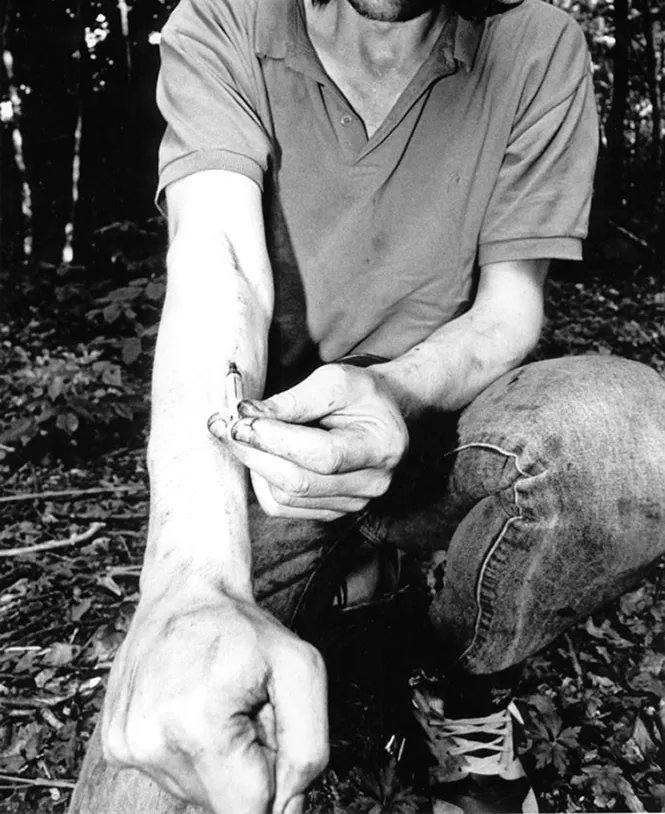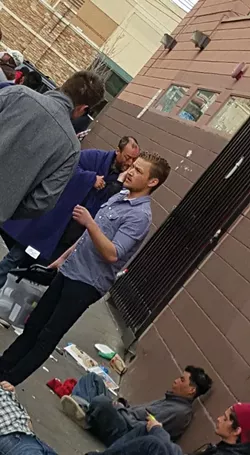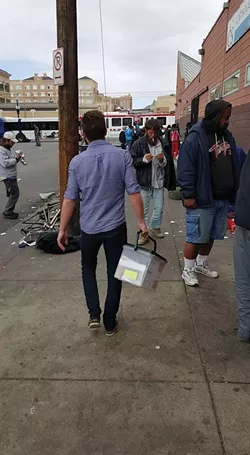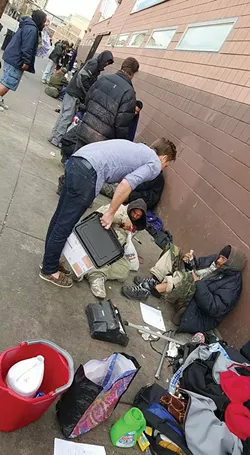"Heroin is a death sentence. People are dying from it every day," says national Drug Enforcement Agency spokesman Rusty Payne. "Fentanyl is 50 times worse."
Three salt-like grains of the synthetic opioid Fentanyl on your skin can prove lethal. "Fent," as it's known on the street, has been used for years by doctors through time-release patches to provide pain relief for people with terminal diseases or chronic pain. It's that synthetic potency which has led drug traffickers to making their own Fentanyl, using chemicals purchased from China, and then mixing it with powdered heroin (called "China White," once a name for heroin itself) or even putting it in pills. Waves of opioid overdose deaths linked to illicit Fentanyl have been reported in recent months on the East Coast, Chicago and New Orleans. In just two weeks in Sacramento, Calif., in late March, 2016, 52 people overdosed from Fentanyl-spiked, fake hydrocodone pills. Fourteen died.

The prognosis is dire, according to testimony given in mid May 2016 by a senior DEA official to a U.S. House judiciary subcommittee. "The yearly market for illegal non-medical prescription pain relievers is over 11 million people, and if Fentanyl is introduced into even a small portion of that overall market, there is a likelihood that overdoses will increase," he said.
Fentanyl offers vast profit margins compared to heroin, which requires significant investment in land, cultivation and refining. A kilo of Fentanyl from China costs just $3,000-$5,000 but—because of its potency—it can generate revenues of $1.5 million stateside, according to the DEA official's testimony.
As of yet, no deaths related to illegally manufactured Fentanyl have been reported in Utah. And that has cops and advocates worried.
University of Utah Department of Pediatrics program manager Sam Plumb first heard about Fentanyl overdoses from a San Francisco counterpart, who described, he recalls, going from receiving calls about lone individuals overdosing, to suddenly seven people all fatally overdosing in a single location. "They got batches they thought were heroin, but they were 100 percent Fentanyl—and they wiped out that group," he says the advocate told him.
State Medical Examiner Todd Grey is unsure as to why Utah has apparently been spared the Fentanyl-driven death toll that other states have seen. "I suspect it has more to do with how heroin is imported and marketed in Utah," he writes in an email response to questions submitted to his office by a City Weekly reporter. He says at his state agency, "prescription narcotics are still a bigger problem than illicit Fentanyl in terms of the number of deaths we see. I do not doubt this could change very quickly if Fentanyl-laced heroin becomes more commonly sold in Utah."
Plumb, however, says fake Fentanyl is already making itself known on Utah's streets. "I can tell you this: it is already here, 100 percent certainty," he says.

John Eddington is Agent in Charge of the Salt Lake City office of the DEA. "We're seeing an increase in the number of investigations of opioid-related issues that involve Fentanyl," he says, citing fake Oxycodon pills that were found to contain "Fent."
That presence, Plumb says, raises a disturbing issue as Utah currently has no way to effectively monitor the path of destruction illicit Fentanyl is creating across the state.
A veteran police officer, who spoke out about his fears regarding illicit Fentanyl on condition of anonymity because he did not have permission to talk to media, believes that if Salt Lake City tested for Acetyl Fentanyl, which is Fentanyl cut with lactose, "you'd see we have a problem here. We should be testing for Acetyl Fentanyl in every O.D. case."
Part of the problem with identifying whether fake Fentanyl is responsible for fatal overdoses, national DEA spokesman Payne notes, is that the drug converts in the system to "look like an opiate. You've got to be looking at increased testing to determine whether it's there. A lot of the time [medical examiners] are checking the heroin box when it's actually Fentanyl."
Utah tests for pharmaceutical-manufactured Fentanyl. According to a records request submitted to the Utah Department of Health, 118 people died of pharmaceutically derived Fentanyl overdoses in 2010-2014. While the Utah Forensic Toxicology Lab (UFTL) and the Medical Examiner's Office test for standard Fentanyl, they do not test for illicit versions, known as analogs. UFTL director Matt Slawson says the Fentanyl molecule is the same if manufactured legally or illicitly. "Bathtub chemists" introduce chemical impurities, he says, "which can be tested for, provided we are given clues to what to look for," citing Acetyl-Fentanyl and Bytryrul-Fentanyl as two examples of essentially impure Fentanyl. At the moment, his lab "is evaluating the value of adding these analytes to our screening process."
Eddington says testing for illicit Fentanyl is currently being discussed among state agencies. "I think it could be beneficial to have that information," he says. As yet, Slawson is not part of that dialogue, but hopes to be. "To be able to determine 'illicit' [Fentanyl] requires communication between law enforcement agencies and the health department," he says, something he tries "to do as much as possible."
Utah is fourth in the nation for drug overdose deaths, with the Center for Disease Control reporting 603 fatal O.D.s in the Beehive State in 2014 alone. That tragic statistic makes it a state ripe for traffickers seeking increased profit margins by selling Fentanyl-spiked heroin and fake prescription pills to people who are struggling to get the prescription pills that led to their addiction in the first place.

An Oxycodon tablet's street value is calculated by the milligram—an Oxy 80 milligram tab costs $80. For that, you can buy 8-16 hits of heroin on the street. As pressure has been brought to bear on doctors and pill manufacturers to curb practices of over-prescribing, patients who have become addicted to opioids after injuries or other issues turn to cheaper alternatives.
"You cut-off pills and you created this huge heroin culture by doing that," says the veteran cop. That's why, he continues, you see middle-class mothers from Sandy near the shelter buying heroin from the open-air drug market that has festered there for years. With the reduction of drug-related felonies to misdemeanors by the Utah Legislature in 2015, advocates and law enforcement are still waiting to see where funding will come from to provide the significant increases in treatment being made available that are necessary to begin to address Utah's opioid-addiction epidemic. "You can't incarcerate your way out of this," he says. "Treatment is the key."
But to address Utah's overdose problem, a more immediate measure lies in making Naloxone (aka Narcan), a medication which typically almost immediately reverses an opioid overdose, widely available. It can be carried and administered by lay persons. Co-founders of Utah Naloxone, Plumb and his sister Dr. Jennifer Plumb have been passionate advocates for the medication, handing out kits to anyone who asks. Cottonwood Heights Police Department became the first Utah law enforcement agency to issue kits to its officers.
Fentanyl produces a much shorter high than heroin, and lacks the emotional and physical "warmth" and euphoria associated with the latter. While addicts go into a "nod" on heroin and their breathing slows as they overdose, Fentanyl is much faster—and therefore more deadly.
The problem lies, in part, in knowing what your dealer is selling you. "You can hope you have a trusted dealer, but I don't know there's such a thing," Sam Plumb says. The heroin you buy to snort or inject can be cut with anything from rat poison to laxatives or Fentanyl. An unscrupulous or incompetent dealer can make a lethal mix and there's no way for a user to know prior to he or she self-administering a "hotshot," or fatal dose.
And it's the presence of the illicit substance that's filling up morgues nationwide. "Basically, if you are a heroin user right now, you are going to die," says the veteran cop. "You are not going to be able to function as you did in the past. At some point, you're going to get Fentanyl and you're going to die."
What has the anonymous cop particularly concerned—given Utahns' prevalence for pill-popping in a state where Mormons frown upon alcohol—is the recent emergence in local drug busts of "pill presses," where traffickers have been manufacturing fake "oxy" pills containing Fentanyl.

Would addicts knowingly use a drug this lethal? Without a doubt, DEA's Payne says. "People are willing to do this knowing they may die."
But if you've gone to jail, says the veteran cop, for burgling cars to sustain your habit, then come out after a break from drugs, and "slam" (inject) heroin—only for it to be Fentanyl—your body wouldn't stand the shock. The traffickers, he says, "are killing off their money source. I guess there's just so many that want it, they don't care."
With approximately 12 people fatally overdosing a week in Utah in 2014, Plumb fears that the epidemic of opioid overdoses the state has been experiencing in recent years will pale once the full force of the illicit Fentanyl wave bears down on local addict populations. He predicts a spike in overdose deaths, where the numbers will climb in groups of half a dozen or more, rather than individuals.
"It's going to get far worse before it gets any better," he says. Without systems set in place to alert law enforcement, treatment facilities or hospitals about the implications of illicit Fentanyl, he fears for the worst.
Utah, he says, "is unprepared for what is coming. And it's already here."